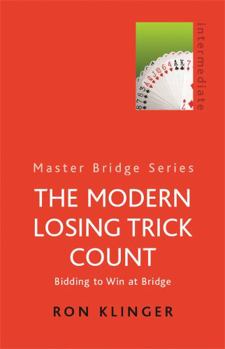Modern Losing Trick Count
Select Format
Select Condition 
Book Overview
If you want to bid accurately and achieve greatly improved results at the bridge table, you have to master the Losing Trick Count. It is a tried and tested method of hand evaluation which has stood the test of time. Ron Klinger, famous international player, author and teacher who has more books to his credit than many players have had good hands, has brought the LTC up to date by relating it to modern systems and conventions.
Format:Paperback
Language:English
ISBN:0304357707
ISBN13:9780304357703
Release Date:May 2001
Publisher:George Weidenfeld & Nicholson
Length:144 Pages
Weight:0.35 lbs.
Dimensions:0.5" x 5.0" x 7.7"
Customer Reviews
5 ratings
On Modern Losing Trick Count
Published by Thriftbooks.com User , 15 years ago
Beyond the counting of high value cards, this is a quick and easy way to further assess the value of your and your partner's hand while in the midst of the bidding process.
An essential element of bidding in contract bridge
Published by Thriftbooks.com User , 18 years ago
In the late 1950's, the Italians began a long streak of World Bridge Championships. And various people pointed out flaws in Standard American bidding. The range of our opening 1-bids was too great. And so on. But when I read the excellent book by Belladonna and Avarelli (two members of the winning Italian team) about the Roman Club system of bidding (this came out in 1959 in the U. S.) I was immediately struck by the emphasis on the number of losers in suit contracts: The number of losers is easy to estimate. xxxx or xxx = 3 losers. Axxx or Axx or KJx or QJx = 2 losers. And so on. An Ace or a King covered a loser in opener's hand. To open the bidding, you needed at least 12 high card points and no more than 7 losers. Suit bidding put a big emphasis on finding out which losers were covered by one's partner. In the present book, Ron Klinger explains a slightly more precise version of calculating losers to arrive at good suit contracts. He starts with a formula: Add your losers to your partner's losers and deduct the sum from 24 to estimate how many tricks you will take. We learn details about how to count losers and how to adjust the losing trick count for trump suit quality, and controls. And there are examples about how to reach (or avoid) games and slams. It's certainly worth reading. By the way, I think that when it comes to competitive bidding, most of these ideas often go out the window if your side and the other side both have long trump suits. The number of trumps you and your partner have in your suit plus the number the opponents have in their suit is roughly equal to the number of tricks you can take in your suit plus the number they can take in theirs! This is sometimes called "the law of total tricks." So you get in the habit of simply bidding the number of trumps you and your partner have between you, not caring if you make or go down. But when you are involved in purely constructive bidding, I think you simply have to count your losers in suit contracts. And if you aren't already doing that, get this book.
Radical Improvement in Bidding
Published by Thriftbooks.com User , 22 years ago
Bidding is over 75% of Bridge and the Losing Trick Count is a quantum leap for bidding. The LTC vastly improves bidding in suit contracts. This book both deepened my understanding of the game and improved my playing. This and OPENING LEADS by Ewen are the two indispensable books about Bridge.
My favourite book on bidding
Published by Thriftbooks.com User , 26 years ago
This is a fantastic book - although quite slim, there is lots of useful content. Using the principles it contains, I was one of the few that found the 24 point slam in the British Bridge League simultaneous pairs in January 1998.
Excellent explanations of this important concept
Published by Thriftbooks.com User , 26 years ago
This is an excellent book that covers a lot of ground in improving a player's bidding. Though the concept is normally used by expert players, Klinger's book is good at helping an intermediate player (like myself) understand these ideas




